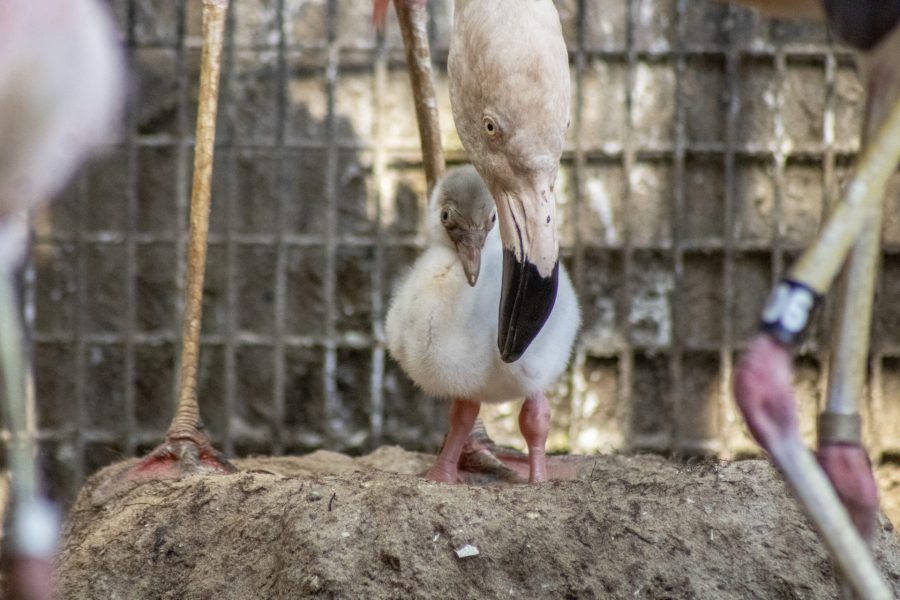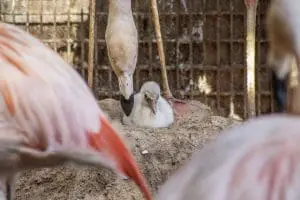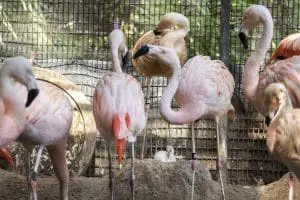

Welcome, little one!
Our flamboyance has become, well, more flamboyant! A chick has hatched to our flock of Chilean flamingos!

This is a first for our Zoo. While we’ve had flamingo animal residents since our opening in 1994, our flock has never laid eggs before. We’ve increased our flock with adult flamingos from other zoos a few times over the years. In 2019, Zoo Atlanta gave our Zoo Chilean flamingo eggs that our animal care team artificially incubated and then hand-reared the resulting three chicks, who were later introduced to the flock.
On Sept. 3, a chick hatched to mom Zinnia and dad Sneaky (dad is actually a member of our original flock in 1994!). Flamingo eggs are still being incubated – some by our flock and others by our animal care team (more on this below), so we hope to have more news soon!
As we celebrate this moment, our animal care team is reflecting on the reasons behind this success – and making plans to take the lessons learned to guide the care of our flock in the future.
Silver Lining to HPAI
It was hard to see many potential positive outcomes when cases of avian influenza (HPAI) were first reported in our area in February. We were so concerned that wild birds carrying this often fatal infection might infect our birds, we made the difficult decision to move most of our birds to indoor habitats.
While most of our birds are now back in their regular habitats, the flamingos are still quarantined in their night house. Birds like our flamingos who spend more time in and around waterways have been found to be more susceptible to HPAI. As it’s currently designed, their original habitat space doesn’t prevent wild birds from interacting with them.
Our flamingos were used to moving into their night house every evening and back to their outdoor habitat in the morning – an important shift to protect the birds overnight from potential predators. Since moving into their night house full-time because of HPAI, the flamingos’ animal care team has been very hands off. This has allowed the birds to settle into a single space and feel comfortable enough to do something they’d never done before: hatch eggs of their own.
In July, five months into their quarantine due to HPAI, keepers spotted the first egg!
Bringing Up Baby Flamingos
This breeding season, our animal care team offered the flock some materials to build nests – even starting a nest for them by mounding clay on top of an overturned bucket. The birds took over, building a fully functional nest on the bucket as well as many nests of their own.
 Flamingos build their nests by standing or sitting at their chosen site and using their beak like a backhoe to drag clay toward them. These round nests can be over 2 feet high with a divot in the middle that lets the egg rest stably. Once the egg is laid, the parents will continue to work on the nest while they incubate the egg.
Flamingos build their nests by standing or sitting at their chosen site and using their beak like a backhoe to drag clay toward them. These round nests can be over 2 feet high with a divot in the middle that lets the egg rest stably. Once the egg is laid, the parents will continue to work on the nest while they incubate the egg.
In their natural range, flamingos are only monogamous for a season, and often change mates each season. In zoos, they have been observed choosing to mate with the same individual each year. The parents typically lay one egg at a time, which if fertile, typically hatches between 28-30 days.
Flamingos Ronald and Rush were the first pair to lay an egg, although the egg did not develop. About 17 eggs have been laid this year – the most recent of which was laid on Sept. 6. Several remain with their parents in a nest on habitat, while the eggs that were not laid on nests were removed to be artificially incubated.
 Sometimes the first round of eggs for a pair are fertile, but if they lay an egg on a nest and later toss the egg out to reclutch (lay another egg), the first egg isn’t usually fertile. There is a higher chance the second egg will be fertile.
Sometimes the first round of eggs for a pair are fertile, but if they lay an egg on a nest and later toss the egg out to reclutch (lay another egg), the first egg isn’t usually fertile. There is a higher chance the second egg will be fertile.
When the chick hatches, both parents will help care for him or her. Our animal care team is trying to be hands off with our chicks, but they will intervene if a chick isn’t being cared for by the parents or appears lethargic.
After the chick hatches, the keepers will look to see that they are fluffy and dry, vocalizing and have good head control. They will also make sure the parent is feeding the chick. Flamingos feed their chicks crop milk, which is produced in their digestive tract and regurgitated. It’s high in protein and fat, and red in color.
Chicks can start leaving their nest as young as 3 days old. They’ll slowly start to expand their boundaries and explore the area around it. Chicks change from their initial gray color to pink slowly over their first few years.
Our flamingos continue to lay and incubate eggs, so we hope to have more good news to share soon!
Extreme Makeover Habitat Edition
Depending on the status of HPAI in our area, we hope to give them access to the rest of their habitat by the end of the year. Keeping in mind the success we’ve had with keeping our flamingos in one set space, we’re looking at renovations we can make to their outside habitat beforehand.
These renovations include leveling out the center island – traveling uphill is not always easy for a long-legged bird.
We are also planning to increase predator protection, which will let us stop having to move the flamingos into their night house overnight. This protection includes hotwiring the perimeter of the fence at night, which will keep bobcats and raccoons from bothering our flock.
Giving the flock the chance to stay in their outdoor habitat 24/7 will give them the chance to work on nest building and egg laying – and up the likelihood of having more chicks!
Please keep an eye on our blog and social media channels for more updates on our flock – and these upcoming renovations.
Brevard Zoo is an independent, not-for-profit organization that receives no recurring government funding for our operating costs. Your generous support enables us to continue to serve our community and continue our vital animal wellness, education and conservation programs.